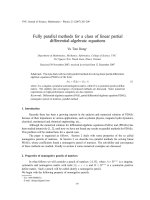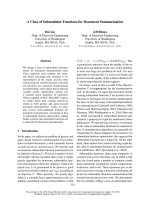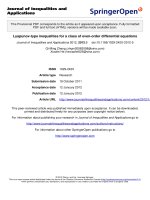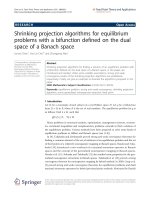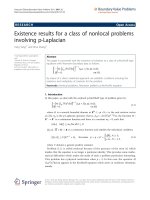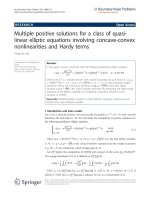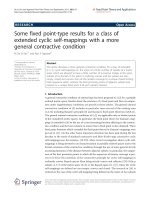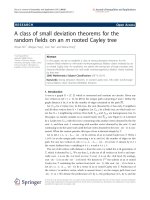Heuristic algorithms for solving a class of multiobjective zero one programming problems
Bạn đang xem bản rút gọn của tài liệu. Xem và tải ngay bản đầy đủ của tài liệu tại đây (1.68 MB, 131 trang )
Heuristic Algorithms for Solving a Class of Multiobjective
Zero-One Programming Problems
ZHANG CAIWEN
(B.Eng.; M.Eng., Civil Eng.)
A THESIS SUBMITTED
FOR THE DEGREE OF MASTER OF ENGINEERING
DEPARTMENT OF INDUSTRIAL AND SYSTEMS ENGINEERING
NATIONAL UNIVERSITY OF SINGAPORE
2003
Acknowledgements
I would like to express my profound gratitude to my supervisor, Associated Professor
Ong Hoon Liong, for his invaluable advice, support, guidance and patience throughout
my study and research.
My sincere thanks are conveyed to the National University of Singapore for offering
me a Research Scholarship and the Department of Industrial and Systems Engineering
for the use of its facilities, without any of which it would be impossible for me to
complete this work.
I want to give special thanks to my research colleagues, Teng Suyan and Liu Shubin,
who have helped me a lot in my research work.
I also want to take this opportunity to thank Ms. Ow Lai Chun from the Department
Office for her very nice and patient assistance.
Special thanks also go out to all my colleagues and friends at the Department of
Industrial and Systems Engineering, the National University of Singapore, who made
my stay at NUS an experience I will not forget.
Last but certainly not least, thanks to my family and my wife for their continuous
concern, moral support and encouragement in this endeavor.
I
Table of Contents
Acknowledgements ...................................................................................................... I
Table of Contents ....................................................................................................... II
Nomenclature ............................................................................................................. IV
List of Illustrations .......................................................................................................V
Summary ... ..............................................................................................................VIII
Chapter 1
Introduction........................................................................................... 1
Chapter 2
A Literature Review ............................................................................ 8
2.1
Approaches aiming to generate a good approximation of the set of
nondominated solutions ............................................................................. 10
2.2
Approaches aiming to generate the set of all nondominated solutions ...... 12
2.3
Approaches aiming to generate one or several “best compromise” solutions
for the decision maker................................................................................. 13
2.4
Real world applications of multiobjective optimization techniques........... 16
2.5
Methods for solving the two classes of problems under study ................... 18
Chapter 3
Basic Concepts and Methodologies .................................................. 22
3.1
Some basic concepts and definitions ......................................................... 23
3.2
Problem formulations ................................................................................. 27
3.3
A simple approach for solving biobjective integer programming problems ..
..................................................................................................................... 31
3.3.1 A simple procedure to generate all nondominated solutions.........................32
3.3.2 A simple approach to generate nondominated solutions of interest .............35
3.4
Computational experiments and results ...................................................... 40
3.5
Summary and conclusions .......................................................................... 49
Chapter 4
Solving the Multiobjective 0-1 Knapsack Problem ......................... 51
II
4.1
Evaluation of an approximation to the nondominated set .......................... 52
4.2
A simple approach for solving biobjective integer programming problems ..
..................................................................................................................... 53
4.2.1 An LP-based heuristic for solving 0-1 integer linear programming problems ..
.......................................................................................................................55
4.2.2 Evaluation of an ε-NS solution .....................................................................63
4.3
Computational experiments and results for biobjective problems ............. 65
4.4
Solving the 3-objective 0-1 knapsack problem .......................................... 70
4.4.1 Property of nondominated solutions to a 3-objective integer programming
problem.........................................................................................................70
4.4.2 An interactive solution approach based on LPH ...........................................75
4.4.3 Computational experiments...........................................................................78
4.5 Summary and conclusions ......................................................................... 81
Chapter 5
5.1
Solving the Multiobjective Generalized Assignment Problem ....... 82
An efficient approach for solving the biobjective generalized assignment
problem ...................................................................................................... 83
5.1.1 Property of the generalized assignment problem .........................................86
5.1.2 An LP-based heuristic for solving the biobjective generalized assignment
problem ........................................................................................................89
5.1.3 Size of subproblem P(5.3) ............................................................................92
5.1.4 Evaluation of an ε-NS solution .....................................................................96
5.1.5 Solution strategies ........................................................................................96
5.2
Computational experiments and results ................................................... 102
5.3
Summary and conclusions ....................................................................... 110
Chapter 6
Conclusions ........................................................................................ 111
References .............................................................................................................. 117
III
Nomenclature
R
The set of real numbers
X
Feasible region
Z
Feasible outcome region
CKP
Continuous knapsack problem
DM
Decision maker
ENS
Extreme nondominated solution
LP
Linear programming
LPH
LP-based heuristic
CV
Cardinality of the expanded FreeSet
MT
Maximum number of trials
T
Turning point
ε-NS solution
ε-Nondominated solution
δ-NS solution
δ-representative nondominated solution
f i (x)
i-th objective function
ε, δ
A small positive value
q
A positive value or equal to ∞
λ
A positive vector with component λi
cj
Attribute value of item j
wj
Weight of item j
W
Capacity of the knapsack
c kj
The k-th attribute value of item j
p ijk
The k-th attribute value of item j if it is assigned to knapsack i
wij
Weight of item j if it is assigned to knapsack i
ci
Capacity of knapsack i
zk
The k-th objective
Z LP
Optimal solution to a linear programming problem
FreeSet
The set containing all free variables
OneSet
The set containing all the variables having value 1
ZeroSet
The set containing all the variables having value 0
IV
List of Illustrations
•
Figures
Figure 3.1
An illustration of the two ENS’s to a biobjective integer
programming problem
Figure 3.2
Flowchart of the procedure in Section 3.3.1
Figure 3.3
Flowchart of the approach described in Section 3.3.2
Figure 3.4
Number of variables versus average number of nondominated
solutions
Figure 3.5
Number of variables versus time taken to generate all nondominated
solutions
Figure 3.6
Number of variables versus average time used to generate each
nondominated solution
Figure 3.7
A plot of nondominated solutions to a typical problem instance with
150 variables
Figure 3.8
A plot of the 101 0.01-NS solutions (100 intervals) to a typical
problem instance with 10000 variables
Figure 3.9
A plot of the 51 0.01-NS solutions (50 intervals) to a typical problem
instance with 50000 variables
Figure 4.1
An illustration of the LP-based heuristic
Figure 4.2
Comparison of the performances of the LPH and CPLEX
Figure 4.3
Performances of the 101 0.01-NS solutions generated by the LPH
and CPLEX for a typical problem instance of size 100
Figure 4.4
Performances of the 101 0.01-NS solutions generated by the LPH
and CPLEX for a typical problem instance of size 500
Figure 4.5
Performances of the 101 0.01-NS solutions generated by the LPH
and CPLEX for a typical problem instance of size 50000
Figure 4.6
An illustration of the first typical case of the distribution of the 3
ENS’s
Figure 4.7
An illustration of the second typical case of the distribution of the 3
ENS’s
V
Figure 4.8
An illustration of the first category nondominated solutions for the
first typical case
Figure 4.9
An illustration of the first category nondominated solutions for the
second typical case
Figure 4.10
An illustration of the small squares in the interactive approach
Figure 4.11a
Generated approximate nondominated frontier to a 3-objective
problem instance of size 1000
Figure 4.11b
Generated approximate nondominated frontier to a 3-objective
problem instance of size 1000
Figure 4.12a
Generated approximate nondominated frontier to the LP relaxation
of a 3-objective problem instance of size 1000
Figure 4.12b
Generated approximate nondominated frontier to the LP relaxation
of a 3-objective problem instance of size 1000
Figure 5.1
ε-NS solutions generated by LPH with the first strategy
Figure 5.2
An illustration of the searching process of the first strategy
Figure 5.3
An illustration of the searching process of the second strategy
Figure 5.4
ε-NS solutions generated by LPH with the second strategy
Figure 5.5
An illustration of the searching process of the third strategy
Figure 5.6
ε-NS solutions generated by LPH with the third strategy
Figure 5.7
Relationship between problem size and ε value
Figure 5.8
Relationship between problem size and time use
Figure 5.9
Relationship between the ratio of n to m and the ε value
Figure 5.10
Generated approximate nondominated frontier for a typical problem
instance of size (200×50)
Figure 5.11
Generated approximate nondominated frontier for a typical problem
instance of size (400×50)
Figure 5.12
Generated approximate nondominated frontier for a typical problem
instance of size (600×50)
VI
Figure 5.13
Generated approximate nondominated frontier for a typical problem
instance of size (800×50)
Figure 5.14
Generated approximate nondominated frontier for a typical problem
instance of size (1000×50)
•
Tables
Table 3.1
Computational results of generating exact nondominated solutions
Table 3.2
Computational results of generating ε-NS solutions
Table 3.3
Time taken to generate 101 0.01-NS solutions (100 intervals)
Table 4.1
Time taken by the LPH and CPLEX to generate 101 0.01-NS
solutions (100 intervals)
Table 5.1a
Relationship between the number of split items n2 and problem size
(for problem instances of data set 1)
Table 5.1b
Relationship between the number of split items and problem size (for
problem instances of data set 2)
Table 5.1c
Relationship between the number of split items and problem size (for
problem instances of data set 3)
Table 5.2
Summary of the computational results
VII
Summary
This thesis is devoted to solving multiobjective zero-one integer linear programming
problems. Although this class of problems has been studied for many years, relative
few effective solution methods have been developed in this field. This study is
particularly concerned with the design and development of heuristics for solving this
class of problems. We present some useful concepts and propose some heuristic
methods for finding the ε-nondominated solutions. The proposed solution method is
quite simple and useful. This method decomposes a multiobjective zero-one
programming problem into a series of single objective problems. Efficient LP-based
heuristics, which capitalize on the similarity between the optimal solution of a zeroone integer linear programming problem and that of its corresponding LP problem, are
employed to solve these single objective problems. In particular, the proposed methods
are applied to two classes of multiobjective zero-one programming problems, i.e. the
multiobjective zero-one knapsack problem and the multiobjective generalized
assignment problem, in this study. Extensive computational experiments have
demonstrated that the methods we proposed are very effective for solving these classes
of problems. These methods can also be extended to other multiobjective zero-one
programming problems, especially the other members from the family of the knapsack
problems.
VIII
Chapter 1 Introduction
–––––––––––––––––––––––––––––––––––––––––––––––––––––––––––––––––––––––––––––––––––
Chapter 1
Introduction
–––––––––––––––––––––––––––––––––––––––––––––––––––––––––––––––––––––––––––––––––––
1
Chapter 1 Introduction
–––––––––––––––––––––––––––––––––––––––––––––––––––––––––––––––––––––––––––––––––––
Numerous real world problems are recognized to have multiple objectives. There does
not just exist a single criterion by which the success of a particular solution can be
measured. Rather, there are multiple criteria to be satisfied or achieved. These criteria
may be conflictive or competitive with one another. Generally all problems have
multiple objectives, but we have tended to think of (and solve) problems as if they
have only one objective (Stanley Zionts, 1992). There are many reasons for the
increasing interest in multiobjective mathematical programming. First and most
importantly, is the increasing recognition that most decision problems are inherently
multiobjective (Evans, 1984). Even many problems addressed by classical single
objective models can easily be viewed as multiobjective in nature.
Multiobjective mathematical programming is one way of tackling real world problems
involving multiple objectives. The topic of multiobjective mathematical programming
is derived from the field of multiple criteria decision making (MCDM) (Steuer, 1986).
Multiple criteria decision making has, however, two distinct halves. One half is multi-
attribute decision analysis and the other half is multiobjective mathematical
programming (multiple criteria optimization). In the absence of a mathematical
specification of the decision maker’s (DM’s) utility function, the extensions in theory
and innovations in technique that enable us to identify the DM’s final solution
constitute the topic of multiobjective mathematical programming (Steuer, 1986).
Multi-attribute decision analysis is most often applicable to problems with a small
number of alternatives in an environment of uncertainty, whereas multiobjective
–––––––––––––––––––––––––––––––––––––––––––––––––––––––––––––––––––––––––––––––––––
2
Chapter 1 Introduction
–––––––––––––––––––––––––––––––––––––––––––––––––––––––––––––––––––––––––––––––––––
mathematical programming is most often applied to deterministic problems in which
the number of feasible alternatives is large. While multi-attribute decision analysis has
been most applicable in resolving difficult public policy problems (nuclear power plant
siting, location of an airport, type of drug rehabilitation program, etc.), multiobjective
mathematical programming is more useful with less controversial problems in business
and government.
The study of multiobjective mathematical programming has occurred since the 1970s.
The most frequently addressed multiobjective mathematical programming problems
include multiobjective linear programming problems and multiobjective integer linear
programming problems. However, it is somewhat surprising that multiobjective integer
programming and combinatorial optimization have not yet been studied widely to date.
A few papers in this area have been published in the 1970s, and then the classical
problems have been investigated in the 1980s. Approximately since 1990 several PhD
thesis have been written, specific methodologies have been developed, and the number
of research papers in this field has grown considerably (Ehrgott and Gandibleux, 2000).
This thesis is particularly concerned with the solution of multiobjective zero-one
programming problems. The two classes of problems considered in this study are the
multiobjective 0-1 knapsack problem and the multiobjective generalized assignment
problem. The single objective case of both problems is NP-hard (Martello and Toth,
1990). Therefore, we can see the difficulties involved in solving multiobjective cases
of these problems.
–––––––––––––––––––––––––––––––––––––––––––––––––––––––––––––––––––––––––––––––––––
3
Chapter 1 Introduction
–––––––––––––––––––––––––––––––––––––––––––––––––––––––––––––––––––––––––––––––––––
Some of the earliest work in the area of multiobjective zero-one programming was
done by Pasternak (1973) and Jaikumar (1973), and presented at the conference on
multiple criteria decision making in South Carolina in 1973 (Rasmussen, 1986). Many
researchers have attempted to solve this class of problems. They have developed
various methods, including exact ones and approximate ones, to solve them. Usually,
the exact ones are based on implicit enumeration techniques, especially the branchand-bound algorithm, while the approximate methods are based on the classical
metaheuristics, such as genetic algorithms, simulated annealing, and tabu search. They
adapted these effective algorithms for solving single objective integer programming
and combinatorial optimization problems to multiobjective context. However, relative
few effective solution methods have been developed in this field to date. As the
multiobjective integer programming and combinatorial optimization problems are
quite different from their single objective counterparts, solution techniques that are
effective for solving the single objective problems may not be viable or work well
within a multiobjective context. On the other hand, the multiobjective metaheuristics
presented in the literature to date can only solve relatively small problems effectively.
Some researchers have studied the multiobjective zero-one programming problems
theoretically, and achieved some results.
In practice, interactive approaches have proven to be most effective in solving
multiobjective mathematical programming problems. These are man-machine
procedures that intersperse phases of computation with phases of decision. Hence,
human intervention in the solution process is one of the characteristics that distinguish
–––––––––––––––––––––––––––––––––––––––––––––––––––––––––––––––––––––––––––––––––––
4
Chapter 1 Introduction
–––––––––––––––––––––––––––––––––––––––––––––––––––––––––––––––––––––––––––––––––––
the methods of multiobjective mathematical programming from those of traditional
single objective mathematical programming.
This research is particularly devoted to the development of approximate methods with
the aim of generating a good approximation to the nondominated frontier of
multiobjective 0-1 integer linear programming problems. Approximate approaches are
widely accepted in solving real world problems, especially when the problem size is
large. One reason for this lies in the fact that the model formulated as well as the data
collected to represent a real world problem is usually not exactly accurate.
Consequently, an optimal solution may not be so desirable from a pragmatic point of
view. A second reason is that the time and computing resource taken to improve the
accuracy of the solutions of NP-hard problems usually increase exponentially, which
makes it not worthwhile to solve them to optimality. Therefore, approximate
approaches are preferred in this study.
In general, for a multiobjective mathematical programming problem a solution that is
optimal with respect to all the objectives does not exist, except for very special cases.
This is because the objectives are usually conflictive or competitive and thus can not
be attained optimally at the same time. As a result, the concept of Nondominated
Solution is adopted in the area of multiobjective mathematically programming. Usually
a multiobjective integer programming problem has many or even numerous
nondominated solutions. Consequently, those methods developed with the aim to
exhaustively generate all nondominated solutions to a multiobjective integer
programming problem are usually not effective or successful. In fact, it is quite
–––––––––––––––––––––––––––––––––––––––––––––––––––––––––––––––––––––––––––––––––––
5
Chapter 1 Introduction
–––––––––––––––––––––––––––––––––––––––––––––––––––––––––––––––––––––––––––––––––––
unnecessary to generate all nondominated solutions, in that too many solutions can
only overwhelm the DM to make an effective decision. In view of this, the approaches
derived in this study only aim to generate a sufficient number of solutions to a
multiobjective 0-1 programming problem, so that the DM can make a decision
effectively.
In this research, we discuss three useful concepts for the solution of multiobjective
integer programming problems: ε-Nondominated Solution, Extreme Nondominated
Solution and δ-representative Nondominated Solution. We propose a simple and useful
method for solving multiobjective integer programming problems. This approach
decomposes a multiobjective integer programming problem into a series of single
objective problems. An efficient LP-based heuristic algorithm, which capitalizes on the
similarity between the optimal solution of a 0-1 programming problem and that of its
LP relaxation, is proposed to solve these single objective problems one by one.
The contents of this thesis are organized in the following way. Chapter 2 provides a
literature review on the methodologies and techniques developed for solving
multiobjective integer programming and combinatorial optimization problems as well
as their applications. Chapter 3 introduces the basic concepts and describes the
methodology developed in this study. In Chapter 4 we describe in details the method
we developed for solving the multiobjective 0-1 knapsack problem, and report the
results of extensive computational experiments. Chapter 5 is devoted to the
development of method for solving the multiobjective generalized assignment problem.
–––––––––––––––––––––––––––––––––––––––––––––––––––––––––––––––––––––––––––––––––––
6
Chapter 1 Introduction
–––––––––––––––––––––––––––––––––––––––––––––––––––––––––––––––––––––––––––––––––––
Finally, Chapter 6 we summarize this research and discuss some possible directions for
future research.
–––––––––––––––––––––––––––––––––––––––––––––––––––––––––––––––––––––––––––––––––––
7
Chapter 2 A Literature Review
–––––––––––––––––––––––––––––––––––––––––––––––––––––––––––––––––––––––––––––––––––
Chapter 2
A Literature Review
–––––––––––––––––––––––––––––––––––––––––––––––––––––––––––––––––––––––––––––––––––
8
Chapter 2 A Literature Review
–––––––––––––––––––––––––––––––––––––––––––––––––––––––––––––––––––––––––––––––––––
Numerous real world decision problems involving multiple objectives can be modeled
as multiobjective integer programming problems. The study of multiobjective integer
programming and combinatorial optimization has occurred since 1970s. Due to the
wide application of this type of problems and the difficulties involved in solving even
the single objective case, it has been receiving great attention since then.
Many researchers have provided extensive literature reviews on this topic. Zionts
(1979) conducted the earliest survey on multiobjective integer programming methods.
Evans (1984) presented a nontechnical overview of many specific solution techniques
for multiobjective mathematical programming, including multiobjective integer
programming. Rasmussen (1986) provided a review focused on zero-one programming
problems with multiple criteria. Teghem and Kunsch (1986a) gave a survey about the
techniques solving multiobjective integer linear programming problems. They (1986b)
also provided a survey on interactive techniques for solving the same class of problems.
White (1990) presented a bibliography on applications of multiobjective methods that
use no a priori explicit value function and were complex enough to require
mathematical programming aids. Ulungu and Teghem (1994a) provided a review on
multiobjective combinatorial optimization problems. They examined a variety of
classical combinatorial optimization problems. Ehrgott and Gandibleux (2000)
conducted a survey of the research in the area of multiobjective combinatorial
optimization and presented an extensive annotated bibliography of it. Jones, Mirrazavi
and Tamiz (2002) gave an overview of the articles concerned with the theory and
–––––––––––––––––––––––––––––––––––––––––––––––––––––––––––––––––––––––––––––––––––
9
Chapter 2 A Literature Review
–––––––––––––––––––––––––––––––––––––––––––––––––––––––––––––––––––––––––––––––––––
application of multiobjective metaheuristics that were drawn from the period 19911999.
This chapter attempts to provide a review into the methods and techniques addressing
the multiobjective integer programming and combinatorial optimization problems that
were presented in the open literature mainly over the past 15 years. We are going to
discuss them according to the following categories.
2.1 Approaches aiming to generate a good approximation to the set of
nondominated solutions
The first group includes the heuristic approaches trying to generate a good
approximation to the set of nondominated solutions. The definition of heuristic given
by Reeves (1995) is a technique which seeks or finds good solutions to a difficult
model. A metaheuristic goes beyond this to draw on ideas and concepts from another
discipline to help solve the artificial system being modeled (Jones, Mirrazavi and
Tamiz, 2002). The most widely used metaheuristics include genetic algorithms, which
emulate the way species breed and adapt in the field of genetics; simulated annealing,
which emulates the way in which a material cools down to its steady state in the field
of physics; and tabu search, which draws on the social concept of ‘taboo’ in order to
provide an effective search technique that avoids local optima. A newly emerged
metaheuristic is the ant colony system, which emulates the behavior of the ant colony
in finding the shortest path for food transportation. However, to our knowledge it has
not yet been used for solving multiobjective integer programming and combinatorial
–––––––––––––––––––––––––––––––––––––––––––––––––––––––––––––––––––––––––––––––––––
10
Chapter 2 A Literature Review
–––––––––––––––––––––––––––––––––––––––––––––––––––––––––––––––––––––––––––––––––––
optimization problems. Most of the heuristics presented in the literature for solving
multiobjective integer programming and combinatorial optimization problems are
based on the extension of the three classical metaheuristics, namely simulated
annealing, tabu search and genetic algorithms to multiobjective context.
Czyzak and Jaszkiewicz (1998) adapted simulated annealing algorithm to
multiobjective context and proposed the Pareto Simulated Annealing that aims to
generate a good approximation of the set of nondominated solutions to a
multiobjective combinatorial optimization problem in a relatively short time. Ulungu,
Teghem, Fortemps and Tuyttens (1999) did a similar thing. They also adapted
simulated annealing to multiobjective case and proposed the so-called Multiobjective
Simulated Annealing (MOSA) algorithm to approximate the set of nondominated
solutions to a multiobjective combinatorial optimization problem. Tuyttens, Teghem,
Fortemps and Nieuwenhuyze (2000) assessed the performance of the MOSA algorithm
developed above by comparing the computational results of its application to the
bicriteria assignment problem against the results from an exact method based on a twophase approach. Gandibleux and Freville (2000) presented a tabu search based
procedure to generate an approximation to the nondominated set of biobjective 0-1
knapsack problems. Marett and Wright (1996) compared the performance of simulated
annealing and tabu search by applying both to a large, complex multiobjective
flowshop problem. It was shown that simulated annealing becomes more attractive
than tabu search as the number of objectives increases. Compared with simulated
annealing and tabu search, very few metaheuristic based on genetic algorithm is
proposed for solving multiobjective integer programming and combinatorial
–––––––––––––––––––––––––––––––––––––––––––––––––––––––––––––––––––––––––––––––––––
11
Chapter 2 A Literature Review
–––––––––––––––––––––––––––––––––––––––––––––––––––––––––––––––––––––––––––––––––––
optimization problems. One example is Tamura et al. (1999) who presented a method
on the basis of genetic algorithm and satisficing tradeoff method and applied it to
flowshop scheduling. Teghem, Tuyttens and Ulungu (2000) adapted simulated
annealing algorithm to the solution of multiobjective combinatorial optimization
problems. An interactive approach is taken to handle large scale problems. This
method was applied to the multiobjective knapsack problem and multiobjective
assignment problem. Erlebach, Kellerer and Pferschy (2001) developed a methodology
for computing a provably good approximation of the nondominated set to the
multiobjective knapsack problem, which is based on a new approach to the single
objective knapsack problem using a partition of the profit space into intervals of
exponentially increasing length. Readers may refer to Jones, Mirrazavi and Tamiz
(2002) for an excellent literature review of multiobjective metaheuristics.
2.2 Approaches aiming to generate the set of all nondominated solutions
The second group consists of those exact approaches which are able to generate the set
of all nondominated solutions. Many of these approaches involve the use of the
branch-and-bound algorithm or its variants. Teghem and Kunsch (1986a) provided a
survey on the methods characterizing the set of nondominated solutions of a
multiobjective integer linear programming problem.
Ulungu and Teghem (1994) extended Martello and Toth’s classical method for solving
the knapsack problem to biobjective version. But they did not conduct any significant
computational experiments. Visee, Teghem, Pirlot and Ulungu (1998) developed two
–––––––––––––––––––––––––––––––––––––––––––––––––––––––––––––––––––––––––––––––––––
12
Chapter 2 A Literature Review
–––––––––––––––––––––––––––––––––––––––––––––––––––––––––––––––––––––––––––––––––––
two-phase methods to generate all nondominated solutions for the biobjective
knapsack problem. In the first phase, the set of supported nondominated solutions is
determined by solving a parameterized single objective knapsack problem. The second
phases of both methods generate all non-supported nondominated solutions with a
branch-and-bound approach, with one using the “breadth first” strategy and the other
using the “depth first” strategy. Li and Shi (2001) proposed a branch-and-partition
algorithm to solve the integer linear programming problem with multicriteria and
multi-constraint levels.
For some earlier works, readers may refer to Klein and Hannan (1982), Kiziltan and
Yucaoglu (1983), and Deckro and Winkofsky (1983), for details.
2.3 Approaches aiming to generate one or several “best compromise”
solutions for the decision maker
The third group comprises the approaches aiming to generate one or several “best
compromise” solutions for the DM. It is noted that many of these approaches
incorporate some interactive procedure. Interactive approaches seem to be drawing
more and more attention in this area over the past 15 years.
White (1985) proposed an approach that is based on an interactive branch-and-bound
procedure and an extension of Lagrangean relaxation methods from single objective
context to multiobjective context to solve multiobjective integer programming
problems. Ramesh, Zionts and Karwan (1986) developed a practical interactive
–––––––––––––––––––––––––––––––––––––––––––––––––––––––––––––––––––––––––––––––––––
13
Chapter 2 A Literature Review
–––––––––––––––––––––––––––––––––––––––––––––––––––––––––––––––––––––––––––––––––––
solution approach for solving multiobjective integer programming problems, which is
based on the combination of a branch-and-bound scheme with the interactive
determination of the decision-maker’s preference structure. Marcotte and Soland (1986)
presented an interactive algorithm for multiobjective optimization, which is also of the
branch-and-bound type. This algorithm applies to those problems which have convex
or discrete feasible set. Gabbani and Magazine (1986) proposed an interactive
approach to solve multiobjective integer linear programming problems heuristically.
Ramesh, Karwan and Zionts (1989) developed an efficient system for representing the
DM’s preference structure. An algorithmic framework that integrates this
representation with a branch-and-bound procedure is developed for solving
multiobjective integer programming problems. Ramesh, Karwan and Zionts (1990)
developed an interactive solution framework for bicriteria integer programming
problems. This framework assumed the DM’s utility function to be pseudoconcave and
nondecreasing and the solution algorithm is an interactive branch-and-bound algorithm.
Aksoy (1990) developed an interactive branch-and-bound algorithm for bicriteria
nonconvex programming problems, which requires pairwise preference comparisons
from the DM.
More recently, a new technique that incorporates reference point/direction into an
interactive framework is attracting more and more attention. Vassilev and Narula
(1993) proposed a reference direction approach and an interactive algorithm to solve
multiobjective integer linear programming problems, in which the DM is required to
provide the reference point at each iteration. Metev and Yordanova-Markova (1997)
employed two auxiliary scalar optimization problems that use reference points to solve
–––––––––––––––––––––––––––––––––––––––––––––––––––––––––––––––––––––––––––––––––––
14
Chapter 2 A Literature Review
–––––––––––––––––––––––––––––––––––––––––––––––––––––––––––––––––––––––––––––––––––
multiobjective optimization problems whose concave functions are maximized over a
feasible set represented as a union of compact convex sets. Alves and Climaco (1999)
proposed an interactive approach that is based on the cutting plane techniques and
Tchebycheff metric for solving multiobjective integer linear programming problems.
This method generates a nondominated solution that is closest to a reference point at
each iteration. And the cutting plane technique allows the method to make use of the
solution information of the previous iterations. Again, Alves and Climaco (2000a)
proposed an interactive reference point approach for multiobjective (mixed) integer
linear programming problems, which employs branch-and-bound techniques for the
solution of Tchebycheff mixed-integer scalarizing programs. Postoptimality techniques
were developed to allow the algorithm to benefit from previous computations. Alves
and Climaco (2000b) developed an interactive method based on simulated annealing
and tabu search to solve multiobjective 0-1 linear programming problems. An
interactive protocol was used to specify reservation levels for the objective function
values. Vassilev, Narula and Gouljashki (2001) presented a learning-oriented
interactive reference direction algorithm for solving multiobjective convex nonlinear
integer programming problems, where the DM sets his preferences as aspiration levels
of the objective function at each iteration of the algorithm.
Remarks:
Each method or technique possesses its advantages and disadvantages. When an
interactive approach requires a lot of inputs from the DM, it could cause some
difficulty during the implementation process. On the other hand, the quality of an
approximation to the nondominated set generated by a heuristic method usually cannot
–––––––––––––––––––––––––––––––––––––––––––––––––––––––––––––––––––––––––––––––––––
15
Chapter 2 A Literature Review
–––––––––––––––––––––––––––––––––––––––––––––––––––––––––––––––––––––––––––––––––––
be guaranteed, which may make the solutions unacceptable to the DM. Most of the
time, researchers rely on existing reference nondominated solutions or reference
nondominated solutions generated by some other exact methods to evaluate the quality
of the approximation generated by the heuristics. Some researchers (see Visee et al.,
1998) tried to propose algorithms with the aim of generating all nondominated
solutions to a multiobjective integer programming problem. This practice is
meaningful theoretically, but the fact that the number of nondominated solutions
increases very fast with the problem size and too many nondominated solutions can
only overwhelm the DM renders it undesirable in practical decision makings.
2.4 Real world applications of multiobjective optimization techniques
Multiobjective integer programming and combinatorial optimization techniques have
been applied to many areas. Many researchers have proposed specific approaches to
solve various real world problems. These problems include: machine scheduling,
project scheduling, crew scheduling, communication, capital budgeting and planning,
transportation, resource allocation, regional development, and so on.
Teng and Tzeng (1996) presented a method for selecting non-independent
transportation investment alternatives. Hapke, Jaszkiewicz and Slowinski (1998)
proposed an approach based on the Pareto Simulated Annealing metaheuristic to
handle quite a general class of non-preemptive project scheduling problems with
renewable, non-renewable and doubly constrained resources, multiple performing
modes of activities, precedence constraints in the form of an activity network and
–––––––––––––––––––––––––––––––––––––––––––––––––––––––––––––––––––––––––––––––––––
16
